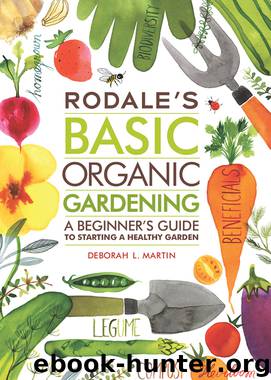Rodale's Basic Organic Gardening by Deborah L. Martin

Author:Deborah L. Martin
Language: eng
Format: epub
Publisher: Rodale
Published: 2014-08-21T04:00:00+00:00
Parsley
Parsley has a multitude of uses in the kitchen. It appears on many a restaurant plate garnishing a steak or fish fillet, but you should eat that little sprig—parsley is rich in vitamin C, containing three times as much by weight as oranges. There are two types—curly parsley and flat-leaf, or Italian, parsley. The frilly, curly kind is more decorative, but many cooks favor the flavor of the flat-leaf type.
Soil: Moist but well-drained soil of average to good fertility.
Temperature: Parsley can go into the garden in spring when the soil temperature warms to about 50°F.
How to plant: Parsley seeds are notoriously slow to germinate, but if you want to try them at home, it’s best to plant them indoors in pots. Soak the seeds in warm water overnight, or for at least several hours, before you plant them. And start early—they can take 4 to 6 weeks to sprout. Keep the potting mix moist. Transplant to the garden when the plants are a few inches high. Moisten the soil before you plant. Space the plants about 8 inches apart.
Care: Keep your parsley well weeded. Water during dry weather (watering at ground level is better than watering from overhead, since parsley is susceptible to crown rot). To keep the plants vigorous, regularly cut outside stems back to the ground. Promptly remove any flowerstalks that form.
How to harvest: Pick stems whenever you need parsley in the kitchen. At the end of the season, you can harvest sprigs and freeze them in self-sealing plastic freezer bags to use over winter. Parsley can be dried, too, but it loses much of its flavor.
Tips for success: Parsley is a biennial, meaning that in warm climates it will survive winter in the garden and grow again a second year. However, during that second season, the plant will bloom and produce seeds. The leaves of flowering parsley are still perfectly edible, although their flavor becomes more pungent. Many gardeners prefer to plant new parsley every year.
Download
This site does not store any files on its server. We only index and link to content provided by other sites. Please contact the content providers to delete copyright contents if any and email us, we'll remove relevant links or contents immediately.
Deep Learning with Python by François Chollet(15956)
The Mikado Method by Ola Ellnestam Daniel Brolund(13223)
Hello! Python by Anthony Briggs(13050)
OCA Java SE 8 Programmer I Certification Guide by Mala Gupta(12233)
Dependency Injection in .NET by Mark Seemann(12078)
Algorithms of the Intelligent Web by Haralambos Marmanis;Dmitry Babenko(10851)
The Well-Grounded Java Developer by Benjamin J. Evans Martijn Verburg(10672)
Grails in Action by Glen Smith Peter Ledbrook(10148)
Secrets of the JavaScript Ninja by John Resig Bear Bibeault(10041)
Kotlin in Action by Dmitry Jemerov(8759)
Test-Driven iOS Development with Swift 4 by Dominik Hauser(8650)
Becoming a Dynamics 365 Finance and Supply Chain Solution Architect by Brent Dawson(8013)
Microservices with Go by Alexander Shuiskov(7784)
Practical Design Patterns for Java Developers by Miroslav Wengner(7671)
Test Automation Engineering Handbook by Manikandan Sambamurthy(7623)
Angular Projects - Third Edition by Aristeidis Bampakos(7104)
The Art of Crafting User Stories by The Art of Crafting User Stories(6568)
NetSuite for Consultants - Second Edition by Peter Ries(6495)
Demystifying Cryptography with OpenSSL 3.0 by Alexei Khlebnikov(6272)
